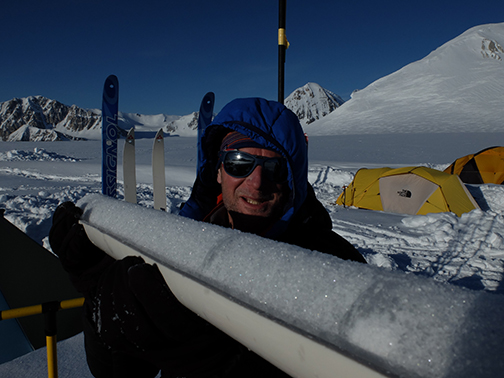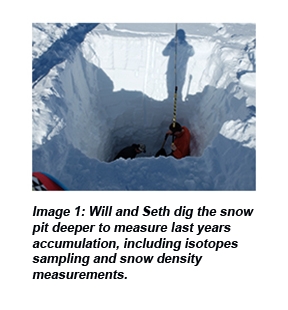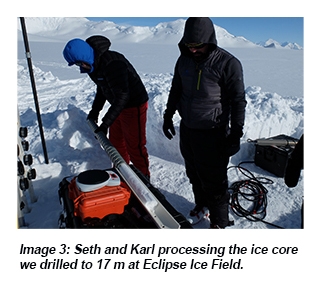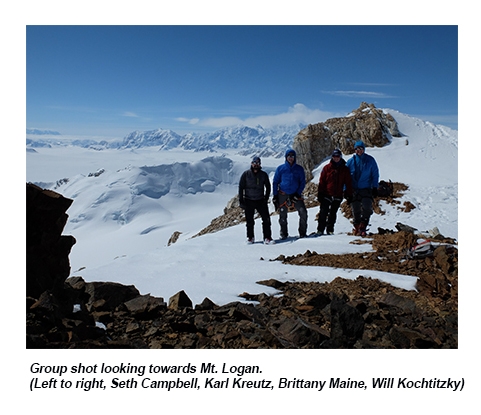
Eclipse Ice Field Expedition – 2017
Understanding Paleo-Climate, Modern Climate, and Glacier Dynamics in Western Canada: Field Report from Eclipse Ice Field
Field Team Members: Karl Kreutz, Seth Campbell, Will Kochtitzky, Brittany Main (University of Ottawa PhD candidate), and Leslie Sobel (Artist)
May 2017
Introduction to Research Project at Eclipse Ice Field: Our research objectives at Eclipse Ice Field are broad including understanding paleo-climate, modern day climate, and ice dynamics. In order to achieve these objectives we employed several techniques during our May 2017 field season to gain a better understanding of Eclipse Ice Field and Donjek Glacier. Eclipse Ice Field is an intriguing location for several reasons. Because there is relatively little melt on Eclipse Ice Field, snow accumulates year after year to build up a record of past climate. By digging snow pits and drilling ice cores, we are able to analyze snow to understand what has happened in the past. We also utilize ground penetrating radar to understand how snow and ice thicknesses vary spatially at this site. This allows us to measure the thickness of the ice across the site and measure the spatially variability of snow accumulation.
We had a productive May 2017 field season at Eclipse Ice Field. Dr. Karl Kreutz (UMaine), Dr. Seth Campbell (UMaine), Will Kochtitzky (UMaine), Brittany Main (University of Ottawa PhD cadidate), and Leslie Sobel (Artist) flew into Eclipse Ice Field on May 16, 2017 to begin fieldwork. During the flight into the field I was able to photograph Donjek Glacier in order to make a three dimensional elevation model of the glacier using structure from motion software. This data will be useful in making modern elevation measurements of the glacier for comparison to other data collected in previous years.
During the second day of the field season, we dug a four-meter snow pit, which represented the accumulation from May 2016 to May 2017 (Image 1). During the May 2016 field season the team had set up an accumulation stake, so we worked at that site to uncover the stake and measure the total accumulation since the stake was installed. We measured the density of the snow in this pit and took samples for oxygen isotope analysis to be complete in Orono.
We were also able to ski several different profiles of ground penetrating radar to collect data on ice thickness and snow accumulation (Image 2). We skied multiple lines across the Eclipse Ice Field to measure the spatial distribution of snow accumulation there and also skied the Donjek Glacier centerline down from Eclipse Ice Field to measure ice thickness and accumulation distribution changes with elevation. These data are awaiting processing to attain final results.
We were also able to drill a 17 m ice core, covering approximately the last 5 years of climate history, to understand recent accumulation and variations in oxygen isotopes (Image 3). We also measured density of the snow and firn to measure the water equivalency of the samples. Finally, we collected a thermistor that was set out during May 2016 on a section of bedrock adjacent to Eclipse Ice Field to measure temperature changes.
In all, we had a productive 2017 field season and are anxious to return in 2018 to collect more data. The ice coming out of Eclipse Ice Field comprises approximately half of the total ice discharge of Donjek Glacier. In order to quantify the accumulation distribution and ice thickness of Donjek Glacier, we plan to organize a field campaign during the summer of 2018 to fly into the other side of Donjek Glacier and ski down the centerline there (the ice field is unnamed). After completion of this work, we will have a complete data set of Donjek Glacier thickness and snow accumulation distribution.
Acknowledgements: I am continually grateful of Dan and Betty Churchill for their continued support in my research endeavors. Thank you to the Churchill Exploration Fund for supporting part of this research expedition. Additionally, this material is based upon work supported by the National Science Foundation Graduate Research Fellowship under Grant No. DGE-1144205. Any opinion, findings, and conclusions or recommendations expressed in this material are those of the authors and do not necessarily reflect the views of the National Science Foundation.





